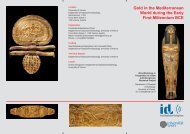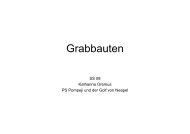RESEARCH REPORT FOR 2008, cont.
RESEARCH REPORT FOR 2008, cont.
RESEARCH REPORT FOR 2008, cont.
Create successful ePaper yourself
Turn your PDF publications into a flip-book with our unique Google optimized e-Paper software.
ASPRO NERO, AGIA IRINI, LIVARI: EXAMINATION AND SUPPLEMENTARY DOCUMENTATION<br />
<strong>RESEARCH</strong> <strong>REPORT</strong> <strong>FOR</strong> <strong>2008</strong>, <strong>cont</strong>.<br />
Drawings and photographic documentation of ‘Cyclopean’ walls north of ‘North Bastion’;<br />
Drawings and photographic documentation of natural ‘Horns of Consecration’;<br />
Plotting, drawing and photography of stray finds (pottery and stone artifacts) of entire site.<br />
Agia Irini (SITE 20 and SITE 21)<br />
This year it has become evident that both sites actually belong to one large FN−EM II<br />
settlement that spreads from the top of Kastri down its southern and eastern slopes.<br />
Completing and fitting together three separate plans of Terrace I, Terrace II, and Terrace III<br />
into one general state plan, no substantial differences are shown in building materials and<br />
techniques of the much eroded, flimsy walls just below the top of the rocky hill, compared to<br />
the sparse remains of similar walls farther downslope admittedly in a very bad state of<br />
preservation. The earlier assumption of a later MM date of the terrace buildings (Schlager<br />
2000) must now be abandoned, although MM pottery on Terrace III is still conspicuous.<br />
Considering the vast amount of FN−EM II material strewn all across the site, the number of<br />
MM sherds on Terrace III only seem to imply a partial reoccupation, perhaps only for<br />
temporary use, of this specific area in the Middle Bronze Age, though no actual MM<br />
architectural remains have been recognized.<br />
Close scrutiny of the very top of the rocky hill, devoid of architectural features, has not<br />
provided any, not even the most insignificant fragments of terracotta statuettes, which one<br />
would expect at the site of an EM hilltop shrine or an MM peak sanctuary, given the<br />
impressive appearance of Kastri as a conspicuous landmark (for seafarers rather than for<br />
landlocked agriculturalists). On the <strong>cont</strong>rary, numerous small fragments of Melian obsidian<br />
blades and cores beside local flints, concentrated in Terraces I and II, seem to hint at knapping<br />
places and other working areas of some specialised craftsmen, who may not only have<br />
acquired or imported foreign raw materials, but have also produced a series of specific tools<br />
on the spot.<br />
Without proper excavation, or at least cleaning of the built-up area of Kastri, the whole extent<br />
and detailed appearance of this large site can only be guessed at. But even the detailed surface<br />
documentation of its visible remains, as achieved in summer <strong>2008</strong>, plotting architectural<br />
remains and stray finds alike, make it one of the largest and best known FN−EM II<br />
settlements known in the wider area between Zakros, Xerokampos, and Goudouras in SE<br />
Crete (cf. Vokotopoulos 2000; Nowicki 2003).<br />
<strong>2008</strong> achievements:<br />
Topographical map of entire site;<br />
Localization of raw material deposits in vicinity;<br />
Supplementation and completion of detailed plans of Terraces I, II, and III;<br />
Joining together of detailed plans into general state plan of top area of Kastri;<br />
Plotting, drawing and photography of stray finds (pottery and stone artifacts) of entire site.<br />
5







